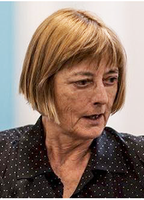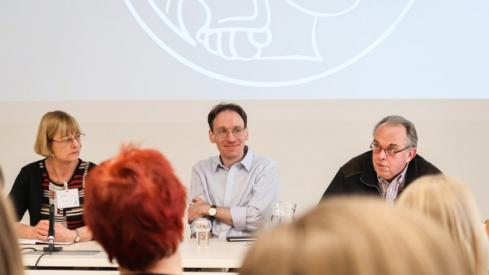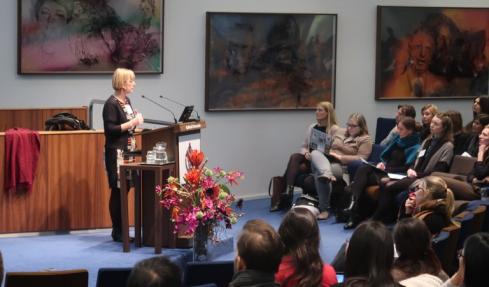An all-encompassing view on Language Development

Since 1982, 37 Nijmegen Lectures have highlighted the challenges, latest findings, and advances in the languages sciences. The accompanying discussions encourage a collaborative, problem-solving approach to multiple aspects of studying language. This year's Nijmegen Lectures were about language development. Elena Lieven, Professor in Human Communication, Development and Hearing at the University of Manchester and Manager Director of the ESRC International Center for Language and Communicative Development (LuCiD) was invited to give three public lectures.
Over three days, Lieven and the invited discussants took about 200 participants on a whistle-stop tour of 53 years of research and argued about how to move forward. As Lieven is known for her groundbreaking research in language development and has witnessed many significant developments in the field during her career, it was an outstanding opportunity to hear her reflect on theories and perspectives in the field. Her history goes back to 1978 with the MPI - which she mentioned to have always been "a broad church for the language sciences."
“I think we’ve all learnt a lot, not only about our current understanding about how children learn language, but about how to move forward from now; I’m excited about the ideas that have been generated by the speakers and the audience over the last three days,” said Caroline Rowland, one of the organizers, and Director of the Language Development Department at the MPI.
Day One: Nature nurture
For the first lecture, on February 26, Lieven addressed the nature-nurture debate; the long-running debate about what kind of innate constraints are built into the language-learning brain. One of the most influential, and historically important proposals we have, is based on the idea is that universal principles of grammar are encoded in our genes and built into the architecture of the human brain. This theory comes with consequences: for example that the input the child receives does not contain all the necessary information to learn a language, and the suggestion that there is a critical period for language learning during childhood. Lieven challenged each of these proposals.
F.l.t.r.: Elena Lieven and MPI directors Simon Fisher and Peter Hagoort, heads of the Departments of Genetics and Neurobiology respectively, during the first Nijmegen Lectures discussion on alternative perspectives on language development.
The afternoon’s discussion session was dedicated to three experts from Nijmegen, who brought unique perspectives from cognitive psychology, from neuroscience and from genetics.
All three speakers suggested ways in which the field might benefit paying attention to research from other areas of the language sciences. James McQueen, Professor of Speech and Learning at Radboud University, suggested that we should conceptualise language acquisition in processing terms; as a result of an emergent language processor that is learning to use, and understand language. Professor Peter Hagoort, Managing Director of the MPI and head of the Neurobiology of Language Department, took up Elena’s theme of “progress since 1965”, suggesting that researchers made a big historical mistake when they paid more attention to Chomksy’s, than Lenneberg’s, ideas about innate constraints back in the 1960s. Professor Simon Fisher - MPI director and head of the Language and Genetics showed, with clear examples from genetics research, how nonsensical it is to try to disentangle the effects of nature-nurture; arguing that instead we should focus on how the two interact, dynamically, as the child develops.
Day two: How children use information to learn language
On the second day of the Nijmegen Lectures on February 27, Lieven outlined her own theory of language acquisition; providing evidence from 20 years' work that shows how children can use the information available in their environments to construct a language system. She summarised a large literature supporting the so-called usage-based theory, which suggests that children’s early knowledge of a grammar starts out as a piecemeal system of rote-learned and semi-formulaic phrases (e.g. what’s X doing, where X can be replaced with a number of words; mummy, daddy doggie, baby etc). On this theory, children don’t need a powerful system of innate linguistic knowledge to learn language; they build a language from the bottom up, by generalising across examples of sentence types that share a similar structure and meaning.
To discuss the usage-based theory further, two experts within the field of language development were invited to debate the proposition "The input [a child receives to learn language] is important but we cannot ignore innate constraints". Anna Theakston, Professor of Developmental Psychology at the University of Manchester, and Petra Hendricks, Professor of Semantics and Cognition at the Faculty of Arts of the University of Groningen. Over a wide ranging discussion, both discussants, and the audience, agreed with the proposition in principle, as well as the important role in language acquisition of the child’s emerging understanding of the world (e.g. their understanding of how other people think and feel). However, they expressed very different views about various aspect of the acquisition process including what type of information is available in the input, how children use this information to build language, and, most crucially, the nature of the proposed underlying innate constraints.
The Nijmegen Lectures presented by Elena Lieven of the Manchester University in the aula of the Radboud University.
Day three: How to compare language development across the world?
As the temperature in Nijmegen plummeted, still nearly all seats were taken in the Radboud University's aula for the last day of the Nijmegen Lectures - to discuss studies of language development across different cultures and languages.
Lieven first described the many different ways in which parents interact with, and bring up their children, demonstrating that our Western child-focussed caregiver styles are by no means the norm. Despite these differences though, she argued, there are surprising commonalities in the age at which children become communicative beings. For example, most children start to point at about 9-10 months of age, she demonstrated, no matter where in the world they are living.
She also raised the problem of how to collect enough data to study language across the world given the remoteness of some of the locations, and the time and money constraints that scientists work under. This is a problem close to the heart of many at the MPI and Radboud University. Elena also reminded the audience that large datasets are not only important for empirical work; they are needed as input data to the large computational models. These models can prove powerful tools for investigating how children learn different languages with very different grammars; showing how differences in the distributional patterning of the input across languages can lead to very different trajectories in children’s development.
Many of these issues were revisited in the afternoon discussion, where Professor Bencie Woll of the University College London, Ludovica Serratrice of the University of Reading, and Steven Levinson - emeritus MPI director and head of the Language and Cognition Department - made the case for working on sign languages, on bilingual acquisition and on languages from non-Western, Educated, Industrialised, Rich, Democratic (WEIRD) societies. These talks beautifully illustrated how different both languages, and the language acquisition process can be, when we take into account children developing in other cultures; from remote villages in Tibet to big northern English industrialised towns, children learning more than one language, and children learning (sign) languages, who are reliant on visual, not spoken, input. The speakers made it quite clear that, if we are to ever converge on an accurate theory of language acquisition, our research must go beyond the study of children learning one language, in Western industrialised societies.
The day, and the lecture series, ended with Lieven summing up the many topics, questions and discussions that had been raised over the three days, focussing on what still has to be done, as well as what we have achieved since 1965. As Rowland put it, "The Nijmegen lectures taught me a lot but perhaps the most important thing I’ve learned is that we still have many exciting discoveries to make”.
More information
- For a more detailed report of the lectures and discussions, a blog post written by Caroline Rowland, director of the Language Development Department at the MPI of Psycholinguistics and co-Director of the ESRC LuCiD Centre, will appear on the LuCiD Centre website (www.lucid.ac.uk)
- The Nijmegen lectures were live tweeted on Twitter using the hashtag #NijLec, where you can follow all the discussions both in the hall and online.


Share this page